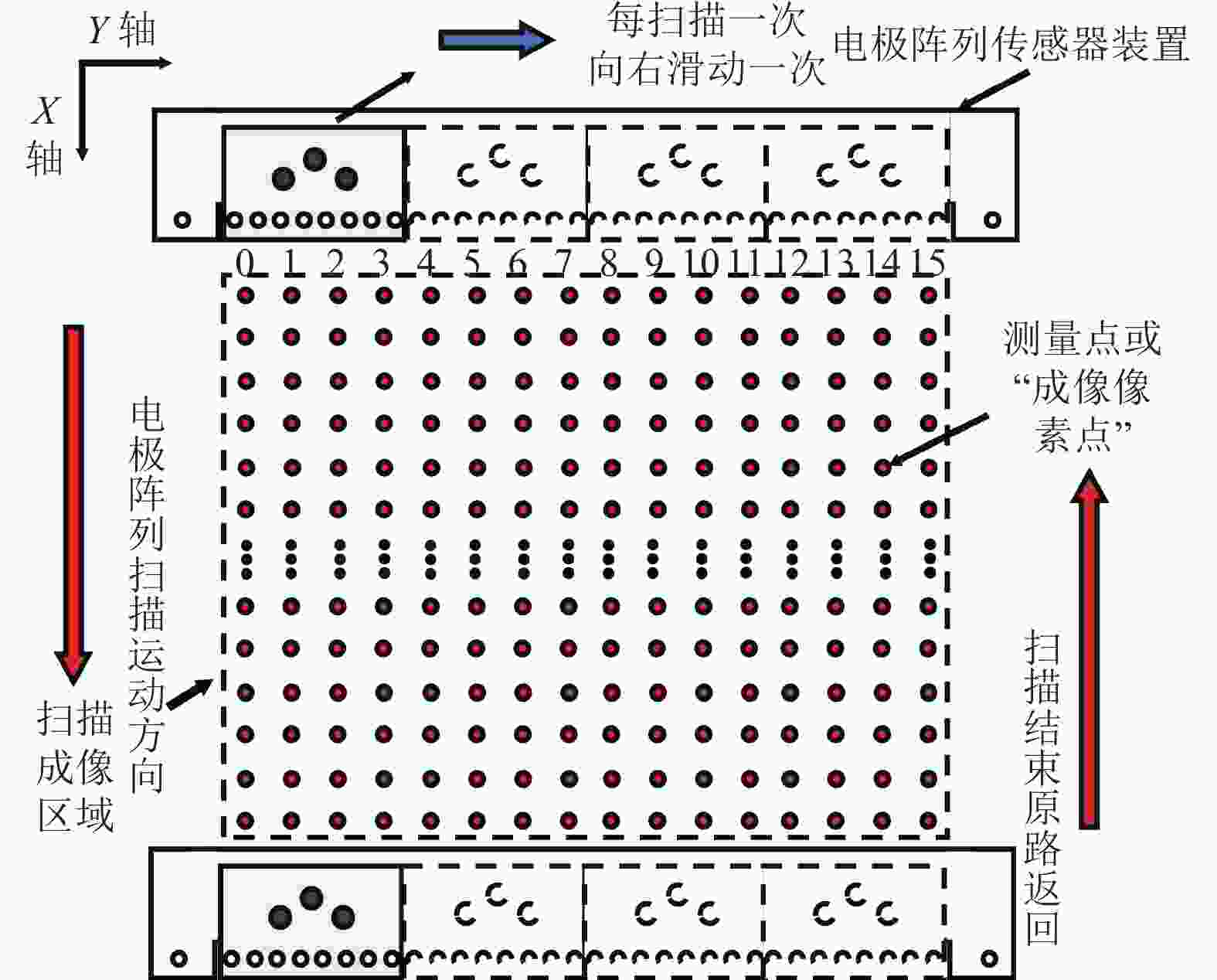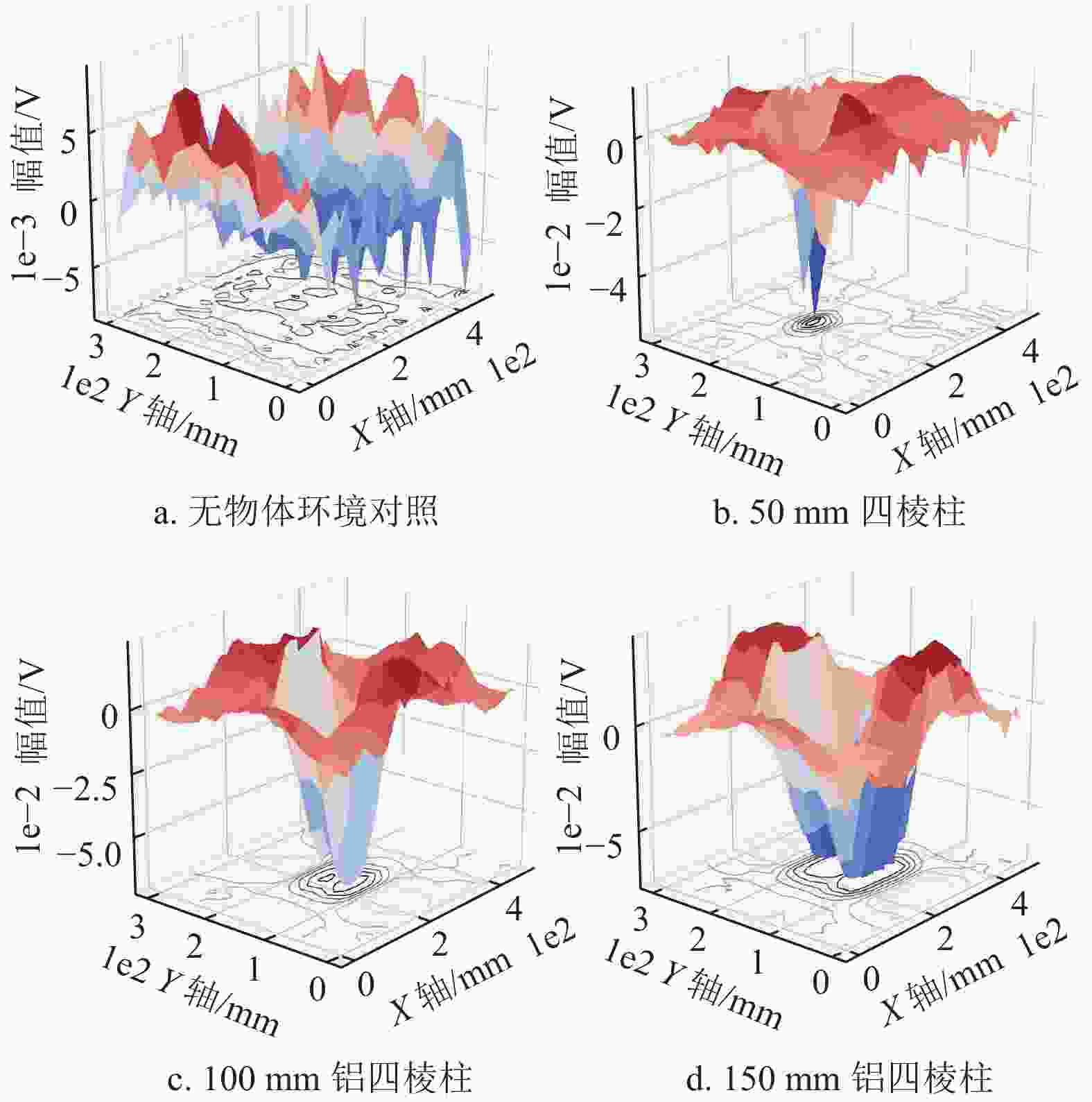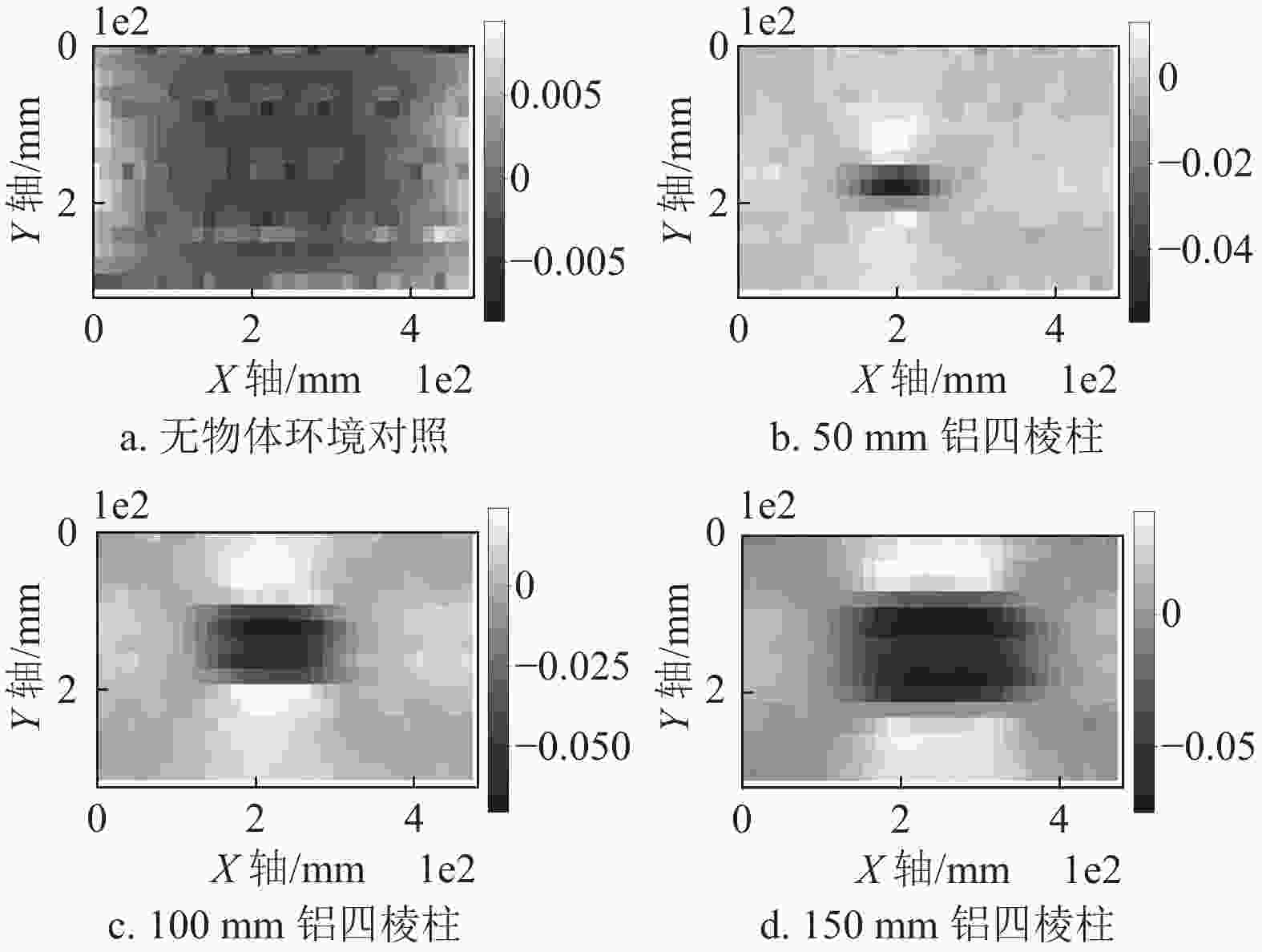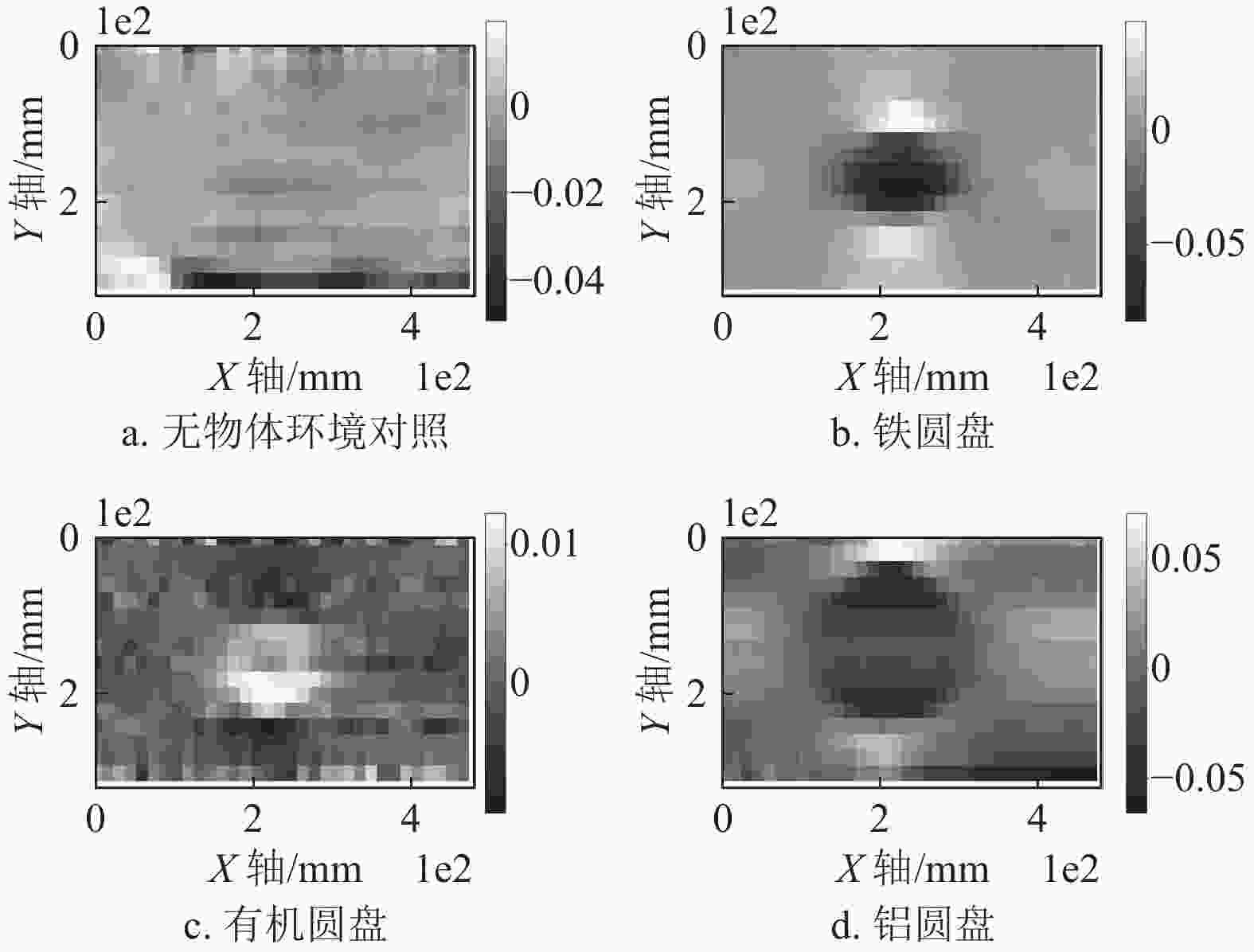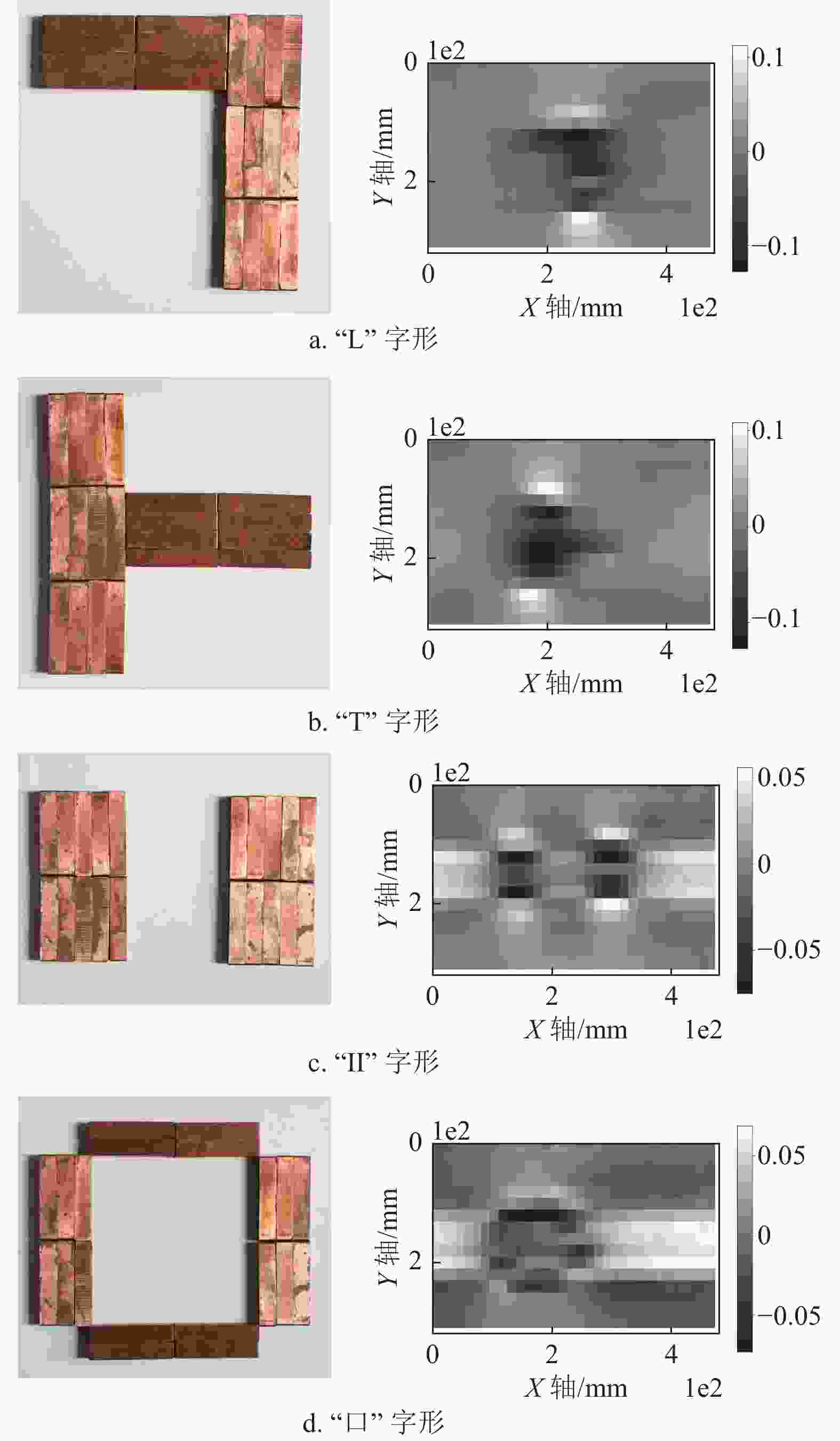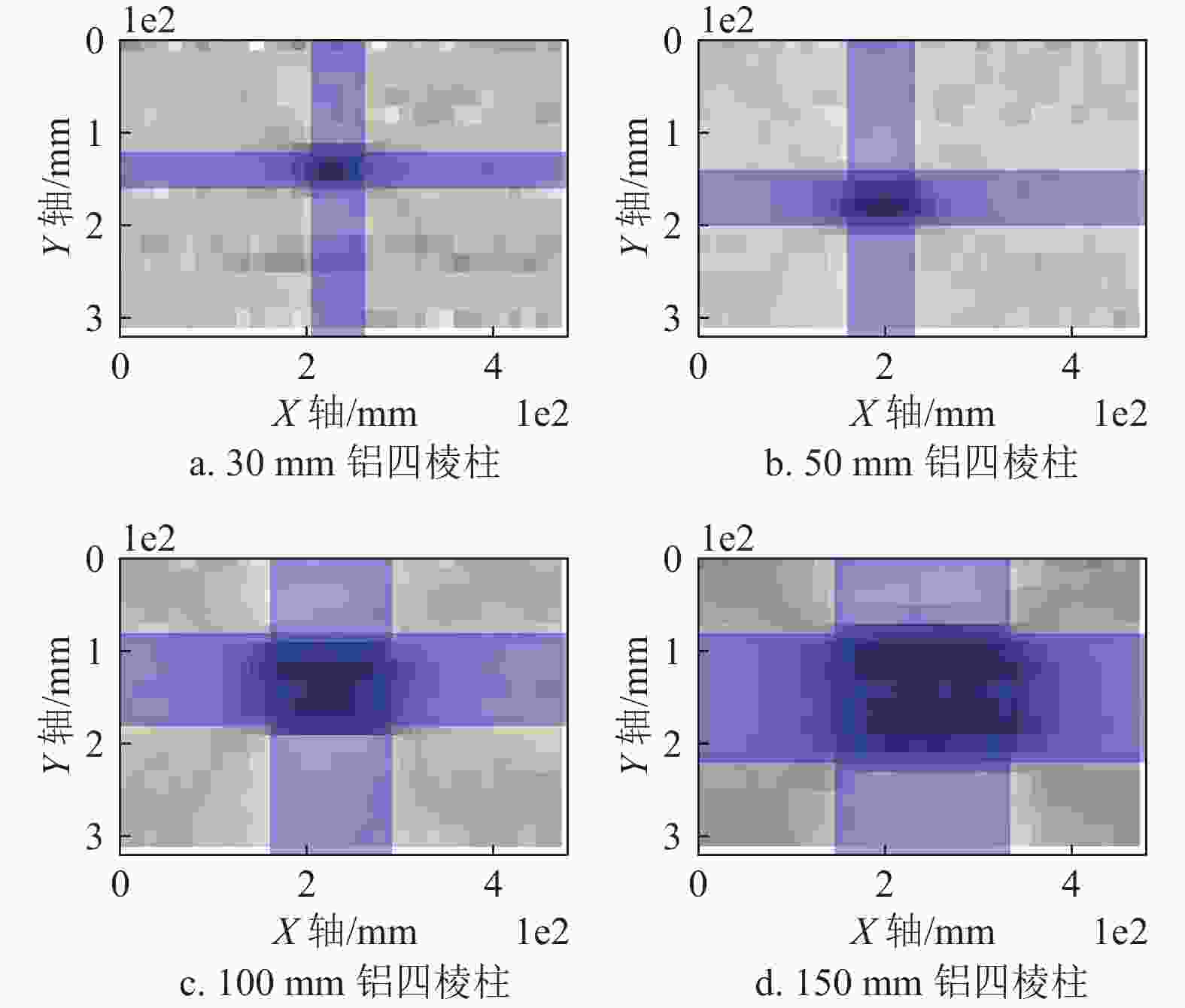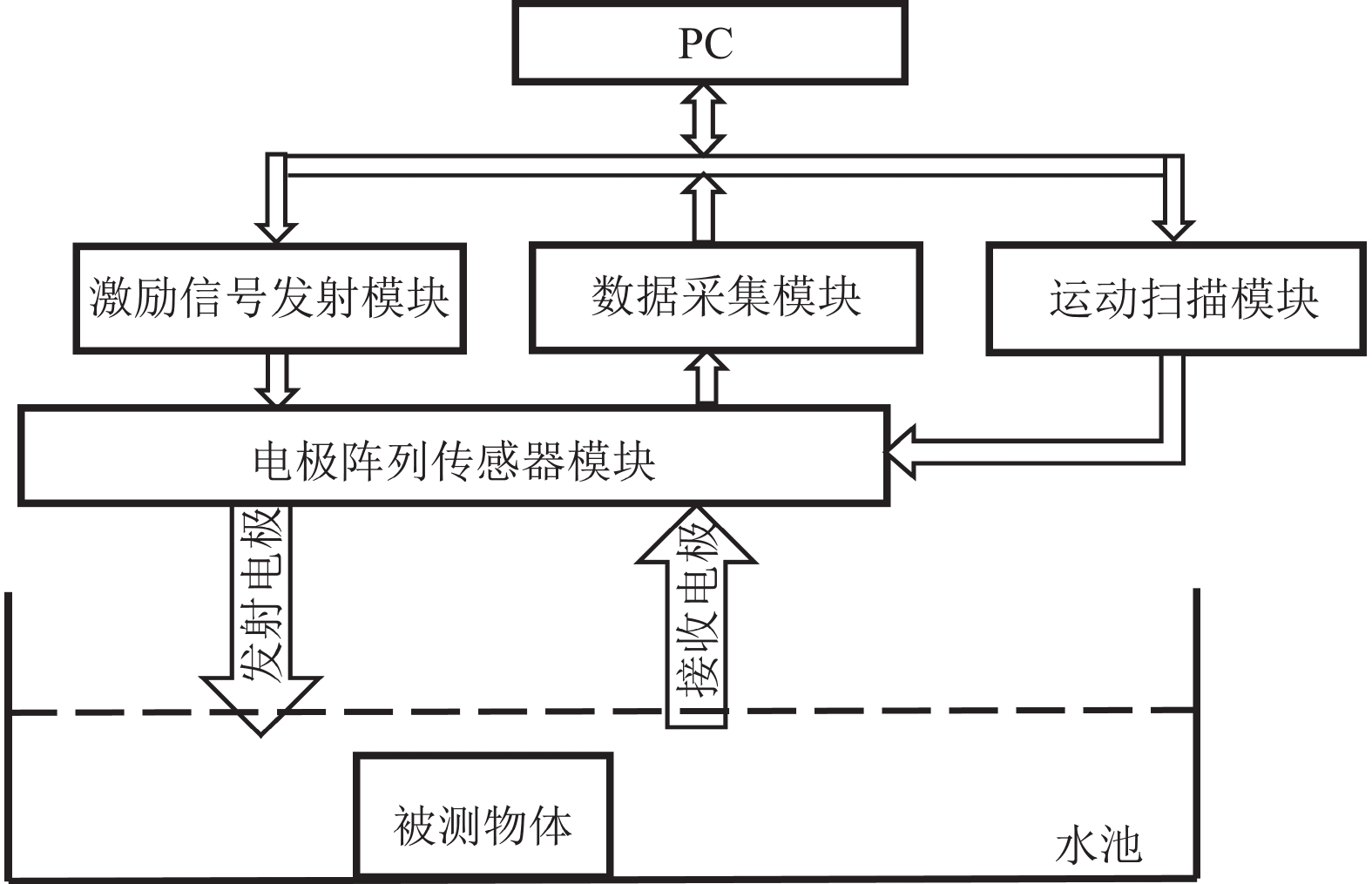-
水下探测领域一直是科学家和工程师研究的重点领域,水下探测技术的发展程度更是体现了大国的核心科技竞争力[1]。其中水下成像技术作为水下探测领域中的关键技术,被广泛应用于水下探测、水下机器人和水下救援任务等多个领域当中[2]。
目前主流的获取水下物体轮廓形状及图像的方法有水下光学成像、水下声纳成像两种 [3-6]。但这两种方法在复杂黑暗的水下环境中都有其缺陷,如水下光学成像方法会由于水下浮游生物及藻类的存在导致太阳光散射、反射甚至吸收,而受到直接影响[7];水下声纳成像方法的空间分辨率较差,水声效应影响显著,探索很小目标时比较困难[8]。水下主动电场成像,其灵感源于弱电鱼主动发射电信号识别周围环境这种生物机制[9-12],学术界对弱电鱼进行大量研究后,得出的主动电场原理已经在水下定位、导航和物体识别等场景中有所应用[13-22]。因此,我们希望利用此方法受水下黑暗、浑浊环境影响程度小的优点来实现复杂水域短距离目标物体形状的成像,为水下成像技术提供一种新的解决方案[23-24]。
主动电场电极阵列幅值法成像的原理在于将被测物体置于发射电极建立好的水下主动电场中时,由接收电极阵列收到的电压幅值改变十分明显,并在时频分布谱图上表现为凸起或者凹陷的幅度改变。这种幅值改变的大小与物体性质、几何特征、电极排布和水体环境等都有关系[25-27],将这种幅值变化与电极位置信息结合起来,即可描绘出图像。
2009年,Nguyen等人利用传感器阵列获得主动电场电压幅值,来测绘水中塑料小球的图像[12]。但是他们的工作未对复杂几何形状和不同材料的物体的成像进行研究。2019年,Gottwald等人使用7×7接收电极阵列仿生弱电鱼生物机制,短距离内获取了物体作用电场产生扰动的“电子图像”,并提出使用一种名为“电子轮廓”的定义描述物体形状[24]。他们的验证工作由于接收电极较少,使得成像效果不是很理想。水下主动电场电极阵列成像集成是一个极其复杂的系统工程,要想利用面型电极阵列对物体进行成像时,为了保证足够的成像精度,往往需要数量较多的电极阵列,且为了保证成像分辨率,其电极排列间隔不能太大,这需要高昂的成本代价。
因此,我们就现有水下电场成像方式硬件复杂,成本高,效果差以及无针对不同材料的复杂几何特征物体进行成像的研究等问题进行改进。
本文提出基于线型电极阵列运动扫描测量区域内不同位置幅值变化的方法对不同材料的复杂几何形状的水下物体进行成像,核心思想是用线性阵列接收电极集成阵列通过连续运动的方法持续采集数据,代替手工定点采集,极大的提高对水中物体成像的效率,并解决了以往多方向往复运动和定点暂停采集数据效率低的问题[21],以及Gottwald等人的7×7电极阵列区域覆盖有限且物体形状较小等问题。
本文工作为主动水下电场成像方法提供了一种实用的方法,为主动水下电场的运用提供了可能的应用方法。
-
根据实验需求我们构建出水下主动电场的线型电极阵列运动扫描成像平台结构框图,如图1所示。
-
成像系统硬件部分主要包括以下五个模块:线型电极阵列传感器模块、激励信号发射模块、运动扫描模块、数据采集及分析模块和水环境及实验物体模块。
成像流程如下:首先,激励信号在水中建立水下主动电场环境,接着,数据采集卡开始测量电压数据并记录,最后,线型电极阵列装置运动扫描一定区域的水环境,实现水平面上的多点电压采集,来对物体进行成像。
线型电极传感器阵列结构设计如图2所示,包括固定板和滑动板两部分组成,并集成了一对发射电极和四对接收电极。
发射电极正负极分别位于固定板两端,用于传导信号建立电场,四对接收电极分布于滑动板之上,用于接收不同位置的电压信号,并使用差分输入端子横向排列的测量方式。固定板上有四个等距的“三孔固定孔”,用于固定滑动板在这四个位置进行纵向运动扫描,从而提高水下主动电场成像横向、纵向分辨率和成像区域面积,解决了数据采集卡模拟信号输入端不够的问题。每个接收电极孔之间的距离为10 mm,总长度为320 mm。
运动扫描成像过程如图3所示。实验开始前。将装置上的电极浸入水中看,电极阵列传感器装置固定于三轴运动装置上先沿水平X轴方向匀速运动扫描,运动过程中发射电极建立的电场与电极装置同步运动,与此同时数据采集卡同步采集数据,并记录存储不同时间点(位置点)的电压数据。
当单次扫描完成后,暂停数据采集卡的采集功能,此时可以得到四列 (编号0~3、4~7、8~11或12~15) 不同扫描位置点的成像点幅值信息,待返回线型电极阵列至初始位置,随后将滑动板向水平Y轴滑动一个位置,开始进行第二次扫描,直至完成所有16列 (0~15) 幅值信息采集。通过程序控制能够精确控制每次扫描的一致性,循环运动扫描的方式等效于32个接收电极端子同步采集16路差分电压数据。
激励信号发射模块包括信号发生器HDG2102B和功率放大器ATA-308,数据采集及分析模块包括数据采集卡USB-6636和PC,水环境及实验物体模块包水槽和多组实验物体,水槽注入定量水用于建立水下电场环境,设置多组被测物体,主要用于研究物体的特征(体积大小、组成材质、复杂形状)对成像的影响。实验平台见图4。
-
成像平台的软件部分借助LabVIEW软件和Python完成,主要包括以下三个模块:实验数据采集模块、实验数据分析处理模块和幅值成像模块。
实验数据采集模块流程如图5所示,采集过程需要将电压数据按通道编号写入到TDMS文件的通道中,最后判断是否完成了16组电压数据的采集,如果没有完成则滑动线型接收电极沿Y轴至下一位置,重复启动数据采集卡和三轴运动装置正向运动,直至完成16组电压数据的采集,结束程序运行。
实验数据分析处理模块中,对采集到的时域波形电压信号经过STFT短时傅里叶变换转化到频域进行分析处理,且为了能消除其它频率的干扰,只对激励信号频率下的幅值进行分析。
幅值成像模块中,成像原理是计算物体处于电场前后各位置点处的幅值信息差值,来对物体形状进行成像。我们定义一个概念为距离分辨率,是成像点数与物理长度的比值,则Y轴方向距离分辨率为16/320=0.05点/mm。X轴方向距离分辨率和STFT处理密切相关,假设线型电极装置沿X轴运动了L mm,运行速度为V,采样频率为Fs,单位为Hz,STFT变换的窗函数长度为N(假设窗函数重合率为0),则X轴方向的成像点数为
$ M={F}_{S}\times L/(N\times V) $ 距离分辨率为$ {F}_{s}/(N\times V) $ ,仅与Fs、N和V有关系。借助Python编写成像算法。设成像点的坐标为 ((x, y,) λ) 其中x表示横坐标数值,y表示纵坐标数值,λ表示幅值数值。则Y轴的成像点数为16个,X轴成像点数为M个,则每个成像点的坐标可以表示成 ((xi, yj,) λij ),其中
$i \in (0, M)$ ,i为整数;$j \in (0, 16)$ ,j为整数。使用Python的绘图工具根据各成像点的坐标数据确定成像点的位置,根据λij数值确定该位置点的着色颜色,就能够对物体形状进行成像。 -
实验中水介质的电导率为318 μS/cm,长方形水槽的尺寸为90×57×40 cm。信号发生器产生频率为500 Hz,幅值为5 V的正弦信号,功率放大器设置为放大20倍,输出功率约为10 W。三轴运动装置的速度设置为2 cm/s,实际水平X轴方向运行距离为480 mm。数据采集卡的采样频率为10 kHz,满足奈奎斯特采样定理。
将实验物体放置于水槽中心位置,线型电极传感器装置的接收电极和发射电极导电端浸于水中并能够在物体上方连续水平移动,且均使用直径为6 mm的钛金属片电极。我们使用线型电极阵列装置扫描两次成像区域,第一次扫描为无物体放置,第二次扫描为有物体放置于水环境中,数据处理过程中,只需要将两次的扫描的幅值信息相减,就能得出较好的成像图像。
-
实验设置三组不同体积大小的铝四棱柱作为实验物体,研究体积大小对幅值成像的影响。三组四棱柱的尺寸依次为50×50×50 mm、100×100×50 mm、150×150×50 mm。将STFT窗函数长度设置为5000,则X轴生成36个成像点,距离分辨率为36点/480 mm=0.075点/mm,Y轴方向距离分辨率为0.05点/mm,成像时将X轴作为横向,Y轴作为纵向,则横纵距离分辨率之比为3∶2,因此在绘制平面颜色映射图时要保证成像颜色块的横纵比例为3∶2,才能显示出物体真实比例的形状。
如图6所示为不同体积大小的四棱柱的线型电极阵列扫描成像曲面幅值图和无物体环境对照。
图6a中发现当成像区域中无物体时,幅值曲面虽然凹凸不平,但相比于图6b和图6c曲面起伏波动不大。图6b和图6c中均出现了一定程度的凹陷,这种凹陷是金属铝四棱柱存在于电场中引起的,且最低幅值数值相差不大,差异在于凹陷的面积不一致,凹陷面积随着物体体积的增大而增大。
接下来,绘制这三个四棱柱的幅值信息颜色映射二维图,如图7所示。
观察图7a的成像结果,未发现明显的形状信息,成像区域为无明显规律的像素点组成。对比图7b和图7c,我们发现了物体形状越大,其深色区域面积越大,且形状近似正方形,在误差允许范围内,可以证明扫描成像的有效性。而成像形状为长方形的原因在于系统运动扫描过程中,实际运行的距离并不能被准确测量,而造成距离分辨率不完全准确,且由于成像颜色块不是正方形,以及数据处理过程中系统产生的不可计量的误差。
-
我们扩大实验物体的范围,研究不同材质的物体的成像结果。其中圆弧形状的物体是最难成像的,对像素点数目要求较高,本节实验中设置三组不同材质的圆弧型物体,分别为铁材质的锈蚀金属圆盘、聚合材质的有机物质圆盘、铝材质的金属圆环。铁金属圆盘和聚合有机物圆盘的尺寸一致,直径为120 mm,厚度为10 mm,圆环的外直径200 mm,高105 mm,圆环厚度为12 mm。三种材质的实验物体的实物图如图8所示。
如图9所示,为三组不同材质的圆弧型物体的线型电极阵列扫描成像曲面幅值图和无物体环境对照的三维曲面图。
对比观察发现图9a中除边缘外有一定误差,幅值曲面几乎为平面,图9b中铁圆盘幅值曲面出现了明显凹陷,且凹陷程度高于铝圆环,图9c中呈现凸起特征,且凸起程度不是很明显,而图9d中凹陷区域面积最大。
接下来,如图10所示绘制这三个实验物体的幅值颜色映射二维图。
观察图10a,发现没有明显几何特征的形状,像素点颜色无明显变化规律,图10b和图10d中成像结果为近似圆形的暗色区域,而图10c为近似圆形的亮色区域,这是因为成像算法中幅值大于零为明亮色,小于零为暗黑色。图10b和图10c中成像区域面积近似相等,满足铁金属和有机聚合物圆盘的尺寸大小一致。图9d成像面积明显要大于图10b和图10c,且可以发现其圆周的颜色亮度要比中间的颜色亮度要暗,很好的表征了物体是圆环形状而不是圆盘形状。
上述的实验结果表明,线型电极阵列运动扫描幅值成像方法能够对金属和非金属的材质进行成像。金属铁对电场的扰动高于铝和有机材质,金属材质物体的三维幅值曲面图表现为向下凹陷,有机材质物体的三维幅值曲面图表现为向上凸起。
-
本节设置多组复杂多变形状来验证成像系统的可行性。本节使用多个立方体小铜柱拼凑出复杂的形状,小铜柱的体积尺寸为10×10×50 mm,共20个。拼凑出的形状分为为“L”字形、“T”字形、“I”字形及“口”字形。如图11所示,为四种复杂形状的幅值颜色映射图和实物体。
图11中的a~b中左图为小铜柱拼凑的实物图,右图为实物体对应成像的幅值映射颜色图。观察图11a中“L”字形物体成像形状,具有明显横竖折弯形状,大致能反映出物体“L”变化的形状。观察图11b中的“T”字形物体成像形状,具有明显的变化形状。同样,观察图11c和图11d中的成像结果,均能很好的表征出实物的形状。
-
经过实验验证了基于线型电极阵列集成扫描的方式能够很好的对水下物体的形状进行成像。接下来我们思考能否根据幅值信息对成像图片提取出物体的其它特性信息,比如位置信息、物体暴露于电场内的面积信息,并且实现定量化描述。
我们发现物体成像的轮廓区域亮度明显低于周围环境成像亮度,如果能够使用一个特定的阈值参数分割出这种亮度变化,就能够计算物体的位置信息。为了验证此想法,以边长100 mm的四棱柱的实验数据为例,绘制横纵轴向的积分曲线和积分曲线求导后的斜率曲线,如图12所示。
我们发现图12a和图12b中横纵两个方向幅值绝对值积分曲线均出现明显峰值,峰值是物体对水下主动电场扰动量的反映,扰动量越大峰值越高,扰动面积越大,峰值的宽度越宽。通过斜率曲线中的最大值和最小值就能确定积分曲线中变化趋势最大的点,此点是映射图中明暗像素点变化最大的点,可以认为是物体成像的边界分割阈值。
图12a和图12b中的灰色阴影区域即为使用图12c和图12d中曲线最大值和最小值数值框选的,将斜率曲线的最大值和最小值点导入二维成像图中就能对物体处于扫描区域的位置进行定位。
如图13所示,分别使用四个不同体积大小的物体作为实验被测对象,图13a~d分别对应的物体边长大小为30 mm、50 mm、100 mm、150 mm。通过观察我们发现图中紫色阴影交叠区域能够很好的覆盖物体的成像区域。已知成像点的横纵距离分辨率,来计算物体位置,具体坐标数值如表1所示。
我们计算每个像素点的面积约为266 mm2,因此可以根据阴影交叠面积大致估算出物体的横截面面积尺寸,具体数值如表1所示。随着物体体积增大,算法计算的面积误差率逐渐降低。
面积估算的误差原因很多,比如在选择区域分割阈值时是否最合适,横向扫描的运动距离是否精准,像素点的物理面积计算是否准确,都决定着上述的面积误差估计。需要注意到的是,图12的水平竖直阴影交叠面积估算显然只能针对水平放置形状规则的四棱柱,更复杂形状的物体的面积估算,需要根据对图像进行分割才能进行面积估算,本文的面积估算只是浅显的研究。
表 1 不同物体的位置估算和面积估算
边长
(mm)左边缘 右边缘 上边缘 下边缘 实际面积
(mm2)测量面积
(mm2)误差
(%)30 204 262 120 160 900 2327 159 50 160 233 140 200 2500 4364 75 100 160 291 80 180 10000 13091 31 150 145 335 80 220 22500 26473 18 -
根据以上实验结果,并对比以往工作,可以对主动电场原理的线型电极阵列运动扫描成像研究得出以下结论:
1)在对不同体积大小的物体进行成像时,物体越大,成像效果越好,如果物体太小,会变得难以成像,这与单位面积的电极数量即成像分辨率有关。以往实验中,Gottwald等人利用7×7的面型电极阵列,实现了约10 cm2的成像面积,但成像效果不太理想[24],而本文中仅用4对接收电极差分完成了约1500 cm2的成像面积,且成像效果较显著;
一定区域下,要想对小物体成像,则需增加大量电极数量,对成本要求太高,本文提出的线型电极阵列运动扫描方法,用较少数量的电极和采集通道,可推断只需减小电极间距及运动扫描间隔,即可提高成像分辨率,还可以大大增加成像覆盖区域面积;
以往工作中,对于网格区域的数据采集,均采取多方向往复运动和定点暂停采集数据的实验方法,时间成本极高[21],采用自动运动加同步扫描采集的方法缩短了10倍以上的实验时间,大大提高了成像效率,且后续可继续深入研究实现实时成像、同步分析等工作;
2)主动电场幅值成像方法能够对金属材质和非金属材质的物体进行成像,且由于两种材质的物体,其对电场产生的不同的幅值变化特性,使得其可以在成像结果中加以区分,这对实际应用有很大作用;
3)该方法同样能对复杂多变形状的物体进行成像,且利用算法对幅值的绝对值积分曲线进行求导后,可以在成像图片中对物体位置和成像面积大小进行定量化估算,对工程应用有一定帮助。
主动电场成像方法作为一种应用在浑浊、复杂、黑暗的水下环境中的新型成像技术,具有广阔的应用前景,为水下成像技术提供了新的思路。
本文提出的线型电极阵列运动扫描成像方法,解决了现有水下电场成像方式覆盖区域有限,硬件复杂,成本高和效果差等问题,并利用自动运动扫描代替手工定点采集,对不同材料的复杂几何特征物体进行成像,实现了对其成像效率和成像分辨率的一次较大改进,为主动水下电场成像方法提供了一种实用的方法。并且本文最后提出,利用电压幅值数据在成像图片中对物体位置和面积大小进行定量化提取,未来如何对不规则形状的物体进行估算,实现实时成像等,也可以作为新的研究方向。
Research on imaging method of linear electrode array scanning based on active electric field
-
摘要: 水下主动电场幅值法成像的灵感源于弱电鱼主动发射电信号识别周围环境这种生物机制。目前的主动水下成像技术在复杂黑暗的水下环境下仍有一定缺陷,因此一种新的解决方案被提出,即利用水下主动电场原理识别完成短距离目标物体复杂形状的成像。针对此前电极阵列覆盖有限、成像分辨率较小、对较大物体成像时电极数量多造成的成本较高以及缺少对复杂几何特征物体成像的实例等问题,设计了线型电极阵列连续运动扫描并采集数据的幅值成像平台,来对实验物体不同体积大小、不同材质及复杂形状进行成像,并对比结果,最后研究了如何根据横纵向幅值积分斜率曲线的最值点,提取成像图片中的物体位置和面积信息。试验表明了基于主动电场原理的线型电极阵列运动扫描幅值成像的有效性,运动扫描补偿法有效解决了接收电极与采集通道有限的弊端和手工定点采集的时间成本,提高了其对水中物体成像的效率和分辨率,为该技术进一步的工程应用和相关特性研究提供了实用方法。Abstract: Underwater active electric field amplitude imaging is inspired by the biological mechanism that weakly electric fish actively emit electric signals to identify their surroundings. The current active underwater imaging technology still has some shortcomings in the complex and dark underwater environment, so a new solution has been proposed, which is to utilize the underwater active electric field principle recognition to complete the imaging of complex shapes of short-range target objects. Aiming at the previous problems of limited coverage of electrode arrays, small imaging resolution, high cost caused by the large number of electrodes when imaging larger objects, and the lack of examples of imaging complex geometric features of objects, we designed a magnitude imaging platform with continuous motion scanning of linear electrode arrays and data acquisition to image experimental objects of different volume sizes, different materials and complex shapes, and compared the results, and finally investigated Finally, we investigate how to extract the object position and area information in the imaging pictures based on the maximum point of the transverse and longitudinal amplitude integral slope curves. The experiments show the effectiveness of motion scanning amplitude imaging of linear electrode array based on the active electric field principle, and the motion scanning compensation method effectively solves the drawbacks of limited receiving electrodes and acquisition channels and the time cost of manual fixed-point acquistion, and improves the efficiency and resolution of its imaging of objects in water, which provides a practical method for the further engineering application of this technology and the related characterization research.
-
表 1 不同物体的位置估算和面积估算
边长
(mm)左边缘 右边缘 上边缘 下边缘 实际面积
(mm2)测量面积
(mm2)误差
(%)30 204 262 120 160 900 2327 159 50 160 233 140 200 2500 4364 75 100 160 291 80 180 10000 13091 31 150 145 335 80 220 22500 26473 18 -
[1] 吴天元, 江丽霞, 崔光磊. 水下观测和探测装备能源供给技术现状与发展趋势[J]. 中国科学院院刊, 2022, 37(07): 898-909. WU T Y, JIANG L X, CUI G L. Status and trends of energy power supply technologyies for underwater equipment[J]. Bulletin of Chinese Academy of Sciences, 2022, 37(07): 898-909. [2] 赵永强, 戴慧敏, 申凌皓等. 水下偏振清晰成像方法综述[J]. 红外与激光工程, 2020, 49(06): 43-53. ZHAO Y Q, DAI H M, SHEN L H, et al. Review of underwater polarization clear imaging methods[J]. Infrared and Laser Engineering, 2020, 49(06): 43-53. [3] 陈哲, 周旭, 沈洁等. 基于梯度先验的水下图像恢复[J]. 仪器仪表学报, 2022, 43(08): 39-46. CHEN Z, ZHOU X, SHEN J, et al. Underwater image restoration based on gradient prior[J]. Chinese Journal of Scientific Instrument, 2022, 43(08): 39-46. [4] JIAN M W, LIU X Y, LUO H J, et al. Underwater image processing and analysis: A review[J]. Signal Processing: Image Communication, 2021, 91: 116088. doi: 10.1016/j.image.2020.116088 [5] 李鹏, 郑太成, 徐丽华等. 稀疏基阵水下声成像的压缩感知方法[J]. 仪器仪表学报, 2016, 37(08): 1843-1850. LI P, ZHENG T C, XU L H, et al. Compressive sensing method for underwater acoustic imaging using sparse array[J]. Chinese Journal of Scientific Instrument, 2022, 43(08): 39-46. [6] 管风, 韩宏伟, 张晓晖. 水下目标激光成像的可视化模型[J]. 中国激光, 2020, 47(05): 506-513. GUAN F, HAN H W, ZHANG X H. Model for visualization of laser imaging of underwater targets[J]. Chinese Journal of Lasers, 2020, 47(05): 506-513. [7] SHEN Y, ZHAO C J, LIU Y, et al. Underwater optical imaging: key technologies and applications review[J]. IEEE Access, 2021, 9: 85500-85514. doi: 10.1109/ACCESS.2021.3086820 [8] 黄海宁, 李宇. 水声目标探测技术研究现状与展望[J]. 中国科学院院刊, 2019, 34(03): 264-271. HUANG H N, LI Y. Underwater acoustic detection: current status and future trends[J]. Bulletin of Chinese Academy of Sciences, 2019, 34(03): 264-271. [9] LISSMANN H W, MACHIN K E. The mechanism of object location in gymnarchus niloticus and similar fish[J]. Journal of Experimental Biology, 1958, 35(2): 451-451. doi: 10.1242/jeb.35.2.451 [10] CAPUTI A A, BUDELLI R, GRANT K, et al. The electric image in weakly electric fish: physical images of resistive objects in Gnathonemus petersii[J]. The Journal of Experimental Biology, 1998, 201(14): 2115-2128. doi: 10.1242/jeb.201.14.2115 [11] GERHARD V D E. Non-visual environmental imaging and object detection through active electrolocation in weakly electric fish[J]. Journal of Comparative Physiology A, 2006, 192(6): 601-612. doi: 10.1007/s00359-006-0096-7 [12] NGUYEN N, WIEGAND I, JONES D L. Sparse beamforming for active underwater electrolocation[C]. 2009 IEEE International Conference on Acoustics, Speech and Signal Processing, Taipei, Taiwan, 2009: 2033-2036. [13] MACLVER M A, MARK E N. Towards a biorobotic electrosensory system[J]. Autonomous Robots, 2001, 11(3): 263-266. doi: 10.1023/A:1012443124333 [14] MALCOLM A M, FONTAINE E, BURDICK J W. Designing future underwater vehicles: principles and mechanisms of the weakly electric fish[J]. IEEE Journal of Oceanic Engineering, 2004, 29(3): 651-659. doi: 10.1109/JOE.2004.833210 [15] GERHARD V D E, STEFFEN F. Distance, shape and more: recognition of object features during active electrolocation in a weakly electric fish[J]. The Journal of Experimental Biology, 2007, 210: 3082-3095. doi: 10.1242/jeb.005694 [16] LEBASTARD V, CHEVALLEREAU C, GIRIN A, et al. Environment reconstruction and navigation with electric sense based on a Kalman filter[J]. The International Journal of Robotics Research, 2013, 32(2): 172-188. doi: 10.1177/0278364912470181 [17] 何春秋, 彭杰纲. 主动电场管道堵塞内检测方法研究[J]. 仪器仪表学报, 2013, 34(05): 1054-1061. doi: 10.3969/j.issn.0254-3087.2013.05.015 HE C Q, PENG J G. Research on on-line inspection of blockage in pipeline based on active electrolocation[J]. Chinese Journal of Scientific Instrument, 2013, 34(05): 1054-1061. doi: 10.3969/j.issn.0254-3087.2013.05.015 [18] NEVELN I D, BAI Y, SNYDER J B, et al. Biomimetic and bio-inspired robotics in electric fish research[J]. The Journal of Experimental Biology, 2013, 216(13): 2501-2514. doi: 10.1242/jeb.082743 [19] YANG B, JAMES B S, MICHAEL P, et al. Finding and identifying simple objects underwater with active electrosense[J]. The International Journal of Robotics Research, 2015, 34(10): 1255-1277. doi: 10.1177/0278364915569813 [20] PENG J G, ZHU Y, TAO Y. Research on location characteristics and algorithms based on frequency domain for a 2d underwater active electrolocation positioning system[J]. Journal of Bionic Engineering, 2017, 14(4): 759-769. doi: 10.1016/S1672-6529(16)60441-9 [21] 祝悦. 基于主动电场定位的水下终端对接目标定位研究[D]. 电子科技大学, 2017. ZHU Y. Research on Target Location in Underwater Terminal Docking Based on Active Electrolocation[D]. University of Electronic Science and Technology of China, 2017. [22] 杨玉娥, 杜文豪, 刘鲁宁. 基于主动电场定位的海参水下识别技术[J]. 仪器仪表学报, 2021, 41(08): 210-217. YANG Y E, DU W H, LIU L N. Underwater sea-cucumber identification technology based on active electrolocation[J]. Chinese Journal of Scientific Instrument, 2021, 41(08): 210-217. [23] GOTTWALD M, MATUSCHEK A, GERHARD V D E. An active electrolocation catheter system for imaging and analysis of coronary plaques[J]. Bioinspiration & Biomimetics, 2017, 12(1): 015002. [24] GOTTWALD M, HENDRIK H, GERHARD V D E. A bio-inspired electric camera for short-range object inspection in murky waters[J]. Bioinspiration & Biomimetics, 2019, 14(3): 035002. [25] PENG J G. A study of amplitude information-frequency characteristics for underwater active electrolocation system[J]. Bioinspiration & Biomimetics, 2015, 10(6): 066007. [26] PENG J G, Wang Y L, LIU L. A research on effect of probed object shape on frequency inflection point (fip) of underwater active electrolocation system[J]. IEEE Transactions on Applied Superconductivity, 2016, 26(7): 1-5. [27] HAN Y J, WU H L, PENG J G, et al. The effect of object geometric features on frequency inflection point of underwater active electrolocation system[J]. Journal of Marine Science and Engineering, 2021, 9(7): 756. doi: 10.3390/jmse9070756 -


 ISSN
ISSN 




 下载:
下载:

